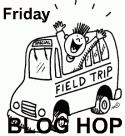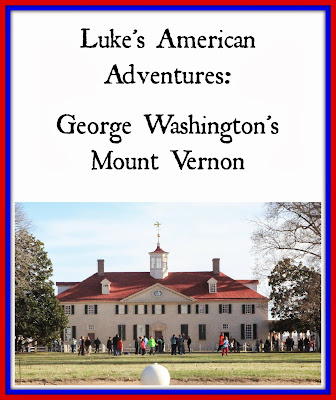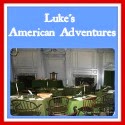Mount Vernon is a plantation originally owned by the Washington family. It is still a working plantation today, but is also open to the public as a memorial museum to George Washington. Our trip gave us a feel of what being on a plantation of the time was like. We viewed the many buildings, animal pens, and crop fields that made up the estate.
There is an admission fee for all visitors. Tickets for people 12 years and older are $17.00, 6 to 11 years old are $8.00, senior, or 62 and older, are $16.00, and 5 years and younger are free. Hours of operation depend on the time of the year. In April through August, it is open 8.00 am through 5:00 pm, March, September, and October 9:00am to 5:00 pm, and November through February 9:00 am through 4:00pm. It is a good idea to purchase them in advance. Tours of the Manor House are by timed ticket, and if you wait to purchase them upon arrival you may not get a time that suits your plans. We had purchased tickets in advance, so we were also able to bypass the admissions queue -- probably about a half hour long.
Our first stop was the estate’s Information Center. In the foyer is this statue of George and Martha Washington and the two grandchildren they adopted.
Although the holiday decor of the Manor House itself is kept true to Washington's era with just some evergreen swags, the visitor areas are decorated with themed trees.
This tree pays tribute to the dove of peace that tops the cupola's windvane.
We began our tour with two informative videos. The first was narrated by Pat Sajak, who you may know as host of the game show Wheel of Fortune. This first film informed visitors about the estate itself, including the many activities to indulge in year-round. Among the activities are both a walking and driving trail that transverse the estate, taking you to all of the major attractions: the Manor, the farms, the Mt. Vernon cemetery, and the distillery. He also reminded everyone that the farm was open all year round, and invited everyone to return to see the farm in different seasons. We went during the Christmas season so we could view Martha’s private quarters and the Christmas Camel, both only available to be seen during the Christmas season.
The second video told about two events in George’s life.
- The first event was how George and Martha met. George was taking a message to Williamsburg, when he encountered a friend along the road who insisted that George stayed for dinner. Once they arrived at the friend’s estate, George met the widow Martha Custis and her children. George and Martha were married on January 6, 1759 at her estate, three months after they first met. Both were 27 years old.
- The second event portrayed was George’s resolve during the Christmas of 1776. He had learned the weak spots in the British army from being a British soldier during the French and Indian War, and when questioned if the attack on Trenton was wise, he told his men, “It is victory or death. This is OUR land.” To win the Revolution, George used what he learned from General Braddock and other British military instructors to beat the British army with their own tactics. Two groups of soldiers crossed the Delaware River on the night of December 25,1776; even if one was sighted, the Hessians would not suspect a second group coming as well. The Continental Army crossed the river and hiked 9 miles to Trenton, New Jersey. 900 Hessians were taken prisoner, but no continental soldiers were killed in the attack. In 1783, George resigned his military commission, as he just wanted to return home to Mount Vernon. The movie ends with his reunion with Martha and his grandchildren.
After the videos, we explored the many sites of the farm, and Celia and I filled out the plantation’s Student Activity Map. It was a foldable booklet containing 10 puzzles and a map of the plantation. The first nine puzzles were standard information fill-in puzzles, each containing a boxed letter. The last puzzle required you to use a boxed letters from the previous puzzles in each spot. Each spot had a number under it corresponding to which puzzle’s letter goes in that spot. At the end of the tour, you can take the map to the Visitor Center. If your answers are correct, you will receive a limited edition Mt. Vernon souvenir pressed penny. While there is a penny pressing machine near the Mt. Vernon Inn, this particular one is only available if you complete the map.
 |
| Animals were an important part of the farm. They helped the farm contain costs by providing raw materials for clothing and household items as well as food. |
In addition, many of the outbuildings of the plantation have been restored or rebuilt.
 |
| Blacksmith Cottage |
 |
| Slave cabin near lower fields |
According to the tombs' guard, Martha’s sarcophagus was on the left, George’s was on the right, and approximately 25 family members were laid to rest in the vault behind them.
 |
| Written on the back wall of the family crypt - John 11:25-26 |
Across from the Washington's mausoleum was a memorial to the slaves who lived and died on the plantation.
We also walked down the hill to the River Landing.
While George was not a picky eater, he was partial to fish, especially fish caught from outside his back door.
While views from atop the bluff were magnificent, along the waterfront itself was beautiful and peaceful. Even the large number of people there spoke in hushed voices, not disturbing the serene landscape.
Late in the day, we visited the manor. As we waited for our ticketed time, we listened to the actor at base of Manor Tour queue, who was portraying Washington's personal valet, Christopher, who became George’s valet in 1790. His job was to do anything George prescribed, including running messages or, in the current case, greet guests waiting for and make sure order is maintained throughout the queue. To keep guests entertained, he shared stories of Washington’s time. Among the stories “Christopher” shared were:
- James Anderson was the man who convinced George Washington to build a distillery. At the time, George Washington grew traditional Virginia crops like corn, wheat, and tobacco. George Washington made a good living as a wealthy plantation owner but much was beyond his control. George Washington wasn’t particularly interested in adding a whiskey distillery to his portfolio, but James Anderson was persistent and kept badgering. Finally, George Washington relented and told James Anderson, "Build a distillery and let me see what you do with it."
- Our tour was slated for 3:50 on a Saturday afternoon. Christopher also mentioned the next day's plans: "Tomorrow I will be traveling with General Washington to Sunday church services. We will be arising before the sun, breaking our fast and then traveling on horseback two and a half hours to Alexandertown." General Washington would attend the morning service while Christopher helped prepare the household for the noon meal. After the noon meal, the Washingtons would return for the afternoon church service, and then all would make the journey back to Mount Vernon to start the farm day on Monday.
At the edge of the line was this tree. There was a plaque on it that said it dated back to 1785. It was huge.
Standing at the base of the tree is my dad. Mom had to go halfway across the field and sit on the grass for this picture, and you still can't get the entire tree in the photograph.
I know what this is! I just studied about Ben Franklin, and one of his inventions is the lightning rod. This tree has a rod put in its highest boughs and a grounding wire run down the side. This helps protect the tree from being killed in a storm. You can see a scorching here where the rod was hit and the system protected the tree.
 |
| Waiting. |
Finally we were entered the manor queue. It starts about 400 feet from the house itself, and winds around to the front door of the house. From the portico outside George's front door, he had an amazing view of the Potomac River.
The house itself consisted of three constructions. The original house, where the entry is, was constructed by George’s father, then a first expansion by George’s half-brother, Lawrence, and then a second expansion made by George. The blue and green paints in the public rooms off the main entrance were exceedingly expensive in colonial times and subtly note George’s wealth. Hanging in the entry is a key to the Bastille, given to George by the Marquis de Lafayette. It was a symbolic gesture that honored George’s commitment to a republican rather than monarch-ruled government. Rooms are carefully furnished with original items, including the furnishings and bedsteads that George and Martha used. The third floor of the house was Martha’s retreat after George’s death, and is only opened to the public around Christmas - four small rooms where no other guests or inhabitants would disturb her. Finally, there is a cupola at top of house, which would be opened or closed based on weather conditions. It was the closest thing to central air, as it would catch the breezes blowing from the Potomac River and lower the houses temperature as much as ten degrees. Overall, it is a beautiful home and I can see why George just wanted to go back and be a private citizen. Watching the sun set over the Potomac River is enough to make me want to live there!
Unfortunately, visitors are not permitted to take photographs in the house itself. I think this probably has to do with the sheer volume of people walking through. We were permitted to take pictures in the kitchens, though.
The photograph on the left is the main kitchen, while the one on the right is of the attached pantry.
As we were leaving the house grounds, we saw a tree that matched the one where we entered the manor queue in both size and stature.
It had a slightly different plaque.
Our trip to Mount Vernon was very informative and educational. I wish we had more time to spend exploring it, and I believe it is a good trip to make if you are in the local area. I would recommend taking the trip around the Christmas season so you can view the third floor of the house, but you can go anytime in the year as it is open year-round. This plaque hangs in the museum center, and I believe the Ladies of Mt. Vernon have accomplished their restoration goal:

©2012- 2013 Adventures with Jude. All rights reserved. All text, photographs, artwork, and other content may not be reproduced or transmitted in any form without the written consent of the author. http://adventureswithjude.com








































Great description and pictures! I'm glad you had decent weather for your visit. We live just over an hour away and have only been once - a day in February when it was free for Washington's birthday. :-) There was so much to see - fascinating place!
ReplyDeleteAwesome! We went to mt.vernon for a field trip when I was in 4th grade! Once we get back east, this is one of many places I want to take my kids! Thanks for linking up at FTF!!
ReplyDeleteI'm excited to take my kids here some day. Thanks for all the pictures.
ReplyDeleteI would love to be able to take the children here one of these days. I love all the pictures and info you shared. Thanks for sharing with Throwback Thursday Blog-Style. I can't wait to see what you share this week.
ReplyDelete